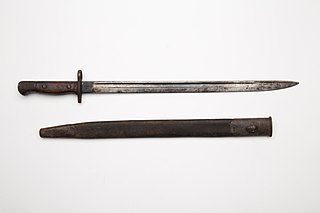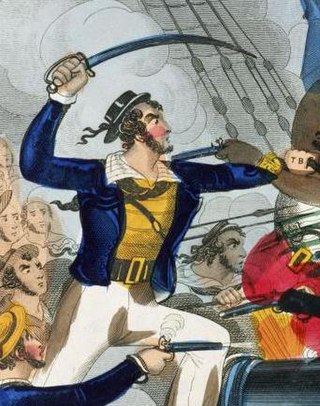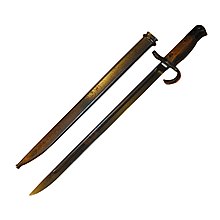
A rifle is a long-barreled firearm designed for accurate shooting and higher stopping power, with a barrel that has a helical or spiralling pattern of grooves (rifling) cut into the bore wall. In keeping with their focus on accuracy, rifles are typically designed to be held with both hands and braced firmly against the shooter's shoulder via a buttstock for stability during shooting. Rifles have been used in warfare, law enforcement, hunting and target shooting sports.

A bayonet is a knife, dagger, sword, or spike-shaped melee weapon designed to be mounted on the end of the barrel of a rifle, carbine, musket or similar long firearm, allowing the gun to be used as an improvised spear in close combats.

Flintlock is a general term for any firearm that uses a flint-striking ignition mechanism, the first of which appeared in Western Europe in the early 16th century. The term may also apply to a particular form of the mechanism itself, also known as the true flintlock, that was introduced in the early 17th century, and gradually replaced earlier firearm-ignition technologies, such as the matchlock, the wheellock, and the earlier flintlock mechanisms such as the snaplock and snaphaunce.
"Brown Bess" is a nickname of uncertain origin for the British Army's muzzle-loading smoothbore flintlock Land Pattern Musket and its derivatives. The musket design remained in use for over a hundred years with many incremental changes in its design. These versions include the Long Land Pattern, the Short Land Pattern, the India Pattern, the New Land Pattern Musket, and the Sea Service Musket.
The yatagan, yataghan, or ataghan, also called varsak, is a type of Ottoman knife or short sabre used from the mid-16th to late 19th century. The yatagan was extensively used in Ottoman Turkey and in areas under immediate Ottoman influence, such as the Balkans, Caucasus, and North Africa.
The Baker rifle was a flintlock rifle used by the rifle regiments of the British Army during the Napoleonic Wars. It was the first British-made rifle that the British armed forces issued as a standard weapon for all line companies in a regiment. The Pattern 1776 Infantry rifle had been issued on a limited basis of 10 per regiment to units serving in the American War of Independence.
A rifled musket, rifle musket, or rifle-musket is a type of firearm made in the mid-19th century. Originally the term referred only to muskets that had been produced as a smoothbore weapon and later had their barrels replaced with rifled barrels. The term later included rifles that directly replaced, and were of the same design overall as, a particular model of smoothbore musket.

Line infantry was the type of infantry that formed the bulk of most European land armies from the mid-17th century to the mid-19th century. Maurice of Nassau and Gustavus Adolphus are generally regarded as its pioneers, while Turenne and Montecuccoli are closely associated with the post-1648 development of linear infantry tactics. For both battle and parade drill, it consisted of two to four ranks of foot soldiers drawn up side by side in rigid alignment, and thereby maximizing the effect of their firepower. By extension, the term came to be applied to the regular regiments "of the line" as opposed to light infantry, skirmishers, militia, support personnel, plus some other special categories of infantry not focused on heavy front line combat.

A rifleman is an infantry soldier armed with a rifled long gun. Although the rifleman role had its origin with 16th century hand cannoneers and 17th century musketeers, the term originated in the 18th century with the introduction of the rifled musket. By the mid-19th century, entire regiments of riflemen were formed and became the mainstay of all standard infantry, and rifleman became a generic term for any common infantryman.

The M1819 Hall rifle was a single-shot breech-loading rifle designed by John Hancock Hall, patented on May 21, 1811, and adopted by the U.S. Army in 1819. It was preceded by the Harpers Ferry M1803. It used a pivoting chamber breech design and was made with either flintlock or percussion cap ignition systems. The years of production were from the 1820s to the 1840s at the Harpers Ferry Arsenal. This was the first breech-loading rifle to be adopted in large numbers by any nation's army, but not the first breech-loading military rifle – the Ferguson rifle was used briefly by the British Army in the American Revolutionary War. The Hall rifle remained overshadowed by common muskets and muzzleloading rifles which were still prevalent until the Civil War. The early flintlocks were mostly converted to percussion ignition.

A bayonet lug is a standard feature on most military and on some civilian longarms. It is intended for attaching a bayonet, which is typically a short-bladed multipurpose knife bayonet. The bayonet lug is the metal mount that either locks the bayonet onto the weapon or provides a base for the bayonet to rest against, so that when a bayonet cut or thrust is made, the bayonet does not move or slip backwards.

The origins of the modern British military rifle are within its predecessor the Brown Bess musket. While a musket was largely inaccurate over 100 yards (91 m), due to a lack of rifling and a generous tolerance to allow for muzzle-loading, it was cheap to produce and could be loaded quickly. The use of volley or mass firing by troops meant that the rate of fire took precedence over accuracy.

A spike bayonet, also commonly known as a socket bayonet, or a pigsticker in informal contexts, is a blade attachment for a firearm taking the form of a pointed spike rather than a knife.

A rifle regiment is a military unit consisting of a regiment of infantry troops armed with rifles and known as riflemen. While all infantry units in modern armies are typically armed with rifled weapons the term is still used to denote regiments that follow the distinct traditions that differentiated them from other infantry units.

A knife bayonet is a knife which can be used both as a bayonet, combat knife, or utility knife as a cutting and thrusting tool or weapon. The knife bayonet became the almost universal form of bayonet in the 20th century due to its versatility and effectiveness. Spike bayonets proved useless when separated from the rifle and ineffective in trench warfare; and while versatile, sword bayonets proved to be impractical weapons in trench warfare because of their overall length. The first knife bayonet to see widespread service was the 10 inch blade Seitengewehr 1871/84, which became the standard German infantry bayonet in 1884. Its derivative, the Seitengewehr 1884/98, would go on in use until 1945 in German service.

An ancillary weapon is a weapon used to supplement a primary or main weapon in the event it cannot be used or is ineffective in a certain application or situation. Examples of ancillary weapons to main weapons include a melee weapon to a ranged weapon, a sidearm to a service weapon, or a light gun to a heavy cannon.

The Pattern 1907 bayonet, officially called the Sword bayonet, pattern 1907 , is an out-of-production British bayonet designed to be used with the Short Magazine Lee Enfield (SMLE) rifle. The Pattern 1907 bayonet was used by the British and Commonwealth forces throughout both the First and Second World Wars.

Ratings of the Royal Navy have used cutlasses, short, wide bladed swords, since the early 18th century. These were originally of non-uniform design but the 1804 Pattern, the first Navy-issue standard cutlass, was introduced at the start of the 19th century. This was a bluntish weapon that was perhaps intended for cutting away canvas and ropes rather than as a thrusting combat weapon. The 1845 Pattern cutlass introduced a bowl-style hand guard which provided greater protection, with a longer and more curved blade. Its sharper point made it more useful for thrusting attacks, which were now emphasised in the drill manual. The 1845 Pattern was modified several times including shortening and straightening the blades, which weakened them. The 1889 Pattern had a straight, spear-pointed blade with a hilt that curved outwards to catch and redirect an opponent's sword point. The 1900 Pattern, the last navy-issue cutlass, was similar to its predecessor with the introduction of a fuller and a hilt insert that cushioned the user's little finger. The cutlass was withdrawn from service in 1936 but remains in use for ceremonial purposes. It is thought that it was last used in combat in 1900 during the Boxer Rebellion.















